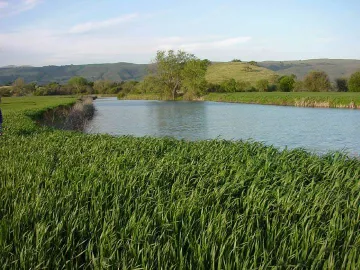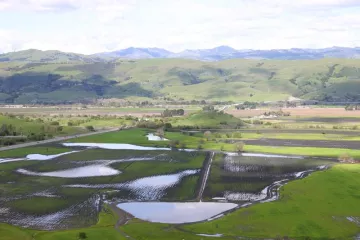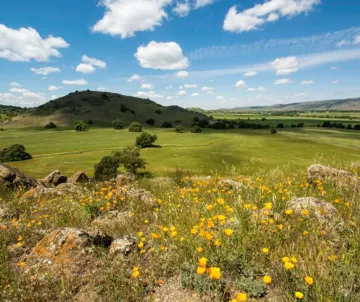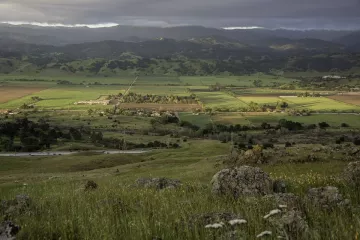Proposed industrial developments in Coyote Valley could jeopardize the groundwater resources that provide much of the drinking water for residents of Santa Clara County. Development proposals would result in changing rare valley floor open space into paved industrial centers with all the associated traffic and pollution. The result would be loss of prime agricultural land, and destruction of essential wildlife corridors and habitat. But special attention must be paid to the pollution of our groundwater supply.
Brian Carr - Loma Prieta Chapter's Open Space Committee
Why Preserving Coyote Valley Protects the Water Supplies for Silicon Valley
by Pat Ferraro

Coyote Valley acts essentially like a 7500-acre percolation pond and is the de facto forebay for the Santa Clara Groundwater Basin, which serves some 2 million residents and businesses in Santa Clara County.
For millennia, the Coyote Valley received the alluvial deposits from the upstream 200 square miles of the Coyote watershed. These alluvial deposits consisted primarily of larger sands and gravels of high porosity and transmissibility. Because of this high porosity, horizontal movement down gradient north toward San Jose through the Coyote Valley has been measured at 10 feet per day. The basin is connected with and greatly influences the stream flow of the main stem of the Coyote Creek and vice versa.
We learned much about our groundwater basins’ physical properties through the unfortunate plume-chasing activities of the 1980’s and beyond, when 10,000 monitoring wells were installed in the county to determine the extent and direction of hundreds of illegal discharges from leaking underground storage tanks.
Despite our county’s leadership in preventing future leaks from buried tanks, land use decisions by both the City of San Jose and Santa Clara County resulted in continued threats to the water quality of the Coyote Valley. The County permitted the use of lands adjacent to Andersen Lake to be used for a rocket testing site, releasing thousands of pounds of perchlorate and other chemicals, many of which are suspected carcinogens, into the watershed. This site continues to be under remediation.
The County staff got approval from the now-defunct Intergovernmental Council to approve the Kirby Canyon Landfill. Once opened, the unlined dump soon began leaking organic solvents, which had mostly been banned by international treaty to protect the planet’s ozone layer.
The relocation and expansion of the 101 freeway from the four-lane Monterey Highway into the eight-lane raceway along the foothills created a greater threat. Normal polluted road runoff multiplied into catastrophic spills from tanker trucks or other collisions, and vehicle fuel and lubricant leaks.
At the very least, signs should be placed along the freeway indicating to motorists that they are entering the Coyote Watershed. Emergency provisions like absorbent should be stockpiled for any catastrophic releases and all storm drains from the freeway discharging to the Coyote Valley should employ carbon filters to remove things like coolants, lubricants and fuel.

Managing polluted stormwater runoff in an area like Coyote Valley cannot be mitigated by installing simple grassy swales to intercept the water. Because the Coyote Valley is of such high porosity, these devices would allow all the dissolved material easy entry into the basin and pollute the underground flow of the basin, estimated at 10 to 50 million gallons of water per day, depending on the prior recent rainfall in the watershed.
We learned a hard lesson during the 1980’s when companies like IBM and Fairchild Semiconductor leaked organic solvents into the groundwater basin, just north of the Coyote Valley. IBM spent around $100 million dollars pumping and treating a cocktail of multiple organic solvents leaked from their buried storage tanks. So much water flowed through the Fairchild site that an underground barrier had to be built around the site to stop the continued contamination of the underground river that flows out of the Coyote into the main Santa Clara Groundwater Basin.
If pollutant loadings to the Coyote Valley Groundwater Basin, and subsequently to the Santa Clara Groundwater Basin, are allowed to increase because of unmitigated urban storm water runoff, eventually the water quality of both basins may reach concentrations of certain pollutants that would require expensive wellhead treatment before use as drinking water for the two million residents and workers of Silicon Valley. This cost would be hundreds of millions of dollars, and the costs would most likely be borne by the tax payers and water rate payers, while the developers would likely skate free of any liability.
It is, therefore, incumbent on us today to remain ever vigilant in protecting our precious groundwater, especially in the forebay region of the Coyote Valley.
Pat Ferraro lectures at San Jose State University on Water Policy, is a former board member of the Santa Clara valley Water District , and was Executive Director of the Silicon Valley Pollution Prevention Center. He has closely followed proposed development of Coyote Valley.
Progress in Preserving Coyote Valley
And What You Can Do
The efforts of the Loma Prieta Chapter and its partners, including Committee for Green Foothills, Greenbelt Alliance, Audubon, and others to oppose development in Coyote Valley are paying dividends. Two key parcels, one of which was proposed as a busy warehouse center, have been purchased by Peninsula Open Space Trust (POST) and will be preserved as open space. The fact that the leading environmental groups in the area are now working together has leveraged their impact and done much to raise public awareness. But we can expect additional development proposals, so much more remains to be done to achieve a complete and final victory.

At risk are rare valley floor wildlife habitat and corridors, one of the largest remaining wetlands in the county (Laguna Seca), flood plains to protect against Coyote Creek flooding, some of the best agricultural land in the county, and sensitive ground water resources. The extension of urban sprawl into the valley would cripple San Jose’s goal of substantially reducing greenhouse gas emissions, and destroy a last vestige of the beautiful “Valley of Heart’s Delight,” which should be preserved for the citizens of the Bay Area for its ecological, recreational, and cultural significance.
Two recent reports have documented the value of Coyote Valley. The Santa Clara Valley Open Space Authority issued a Coyote Valley Landscape Linkage report showing the valley’s importance as a connection between the Diablo Range and the Santa Cruz Mountains, allowing wildlife to migrate, find mates, maintain genetic diversity, and adapt to climate change. POST has announced a major effort to preserve the valley and estimates that $80 million will be required to buy land and development rights.
Two recent reports have documented the value of Coyote Valley. The Santa Clara Valley Open Space Authority issued a Coyote Valley Landscape Linkage report showing the valley’s importance as a connection between the Diablo Range and the Santa Cruz Mountains, allowing wildlife to migrate, find mates, maintain genetic diversity, and adapt to climate change. POST has announced a major effort to preserve the valley and estimates that $80 million will be required to buy land and development rights.

The efforts of POST and others may be limited by land use decisions of the San Jose City Council which may ultimately determine the valley’s fate. The council members are very aware of public sentiment, so if we can muster thousands of supporters, it will be factored into their decision.
As the largest environmental organization in the area, our Chapter members can have a big impact in influencing the council, so if you favor saving this special place, go to the web page and sign on as a Coyote Valley supporter. This includes residents of San Mateo and San Benito counties as preservation of the valley is definitely a regional issue.
Resources
- Understanding Coyote Valley -- Existing Conditions Summary Report from the Santa Clara Open Space Authority.